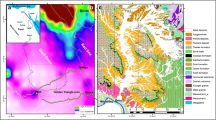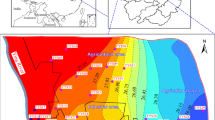Abstract
The relationship between soil cave development and the chemical characteristics of groundwater in a karst area was investigated. The purpose of the investigation was to identify potential soil caves and predict their collapse. Field surveys and monitoring were carried out, and statistical analysis, and geological comparison methods were used to analyze the relationships between Ca++, HC\({\text{O}}_{3}^{ - }\), TDS, (Na++K+)/(Na++K++Ca++), Cl–/(Cl– + HC\({\text{O}}_{3}^{ - }\)) and soil cave development. Gibbs charts and Piper diagrams were used. The results show that the development of soil caves can be identified from groundwater chemistry indicators. All hidden and collapsed soil holes were located on a strong development zone that was identified using Gibbs charts. This study provides a new approach for the monitoring of soil cave development and for early-warning of soil cave collapse using macro-scale groundwater chemistry.






Similar content being viewed by others
REFERENCES
A. A. Baryakh and A. K. Fedoseev, “Sinkhole formation mechanism,” J. Mining Sci. 47 (4), 404–412 (2011).
I. García-Moreno and R. M. Mateos, “Sinkholes related to discontinuous pumping: susceptibility mapping based on geophysical studies. The case of Crestatx (Majorca, Spain),” Environ. Earth Sci. 64 (2), 523–537 (2011).
R. J. Gibbs, “Mechanisms controlling world water chemistry,” Science 170, 1088–1090(1970).
I. Gratchev and I. Towhata, “Compressibility of natural soils subjected to long-term acidic contamination,” Environ. Earth Sci. 64 (1), 193–200 (2011).
F. Gutiérrez, M. Parise, J. De Waele, and H. Jourde, “A review on natural and human-induced geohazards and impacts in karst,” Earth–Sci. Rev. 138, 61–88 (2014).
N. E. Kalinkina, V. P. Rudakov, and V. V. Tsyplakov, “Some features of fluid dynamics at platforms as illustrated by the example of variations in subsoil radon and seismic noises in the Moscow and Nizhni Novgorod regions,” Geochem. Int. 45 (1), 87–91 (2007).
Y. R. Kang, “Forming condition of land collapse in karst regions,” Carsologica Sinica 7 (1), 9–18 (1988) (In Chinese).
B. X. Liang, Y. Tan, L. G. Jiang, and B. B. Jiao, “Effects of freeze–thaw and drying-wetting cycles on slaking characteristics of mudstone,” Chin. J. Geotechn. Eng. 4,705–711 (2016).
J. L. Shelton, M. A. Engle, A. Buccianti, and M. S. Blondes, “The isometric log-ratio (ilr)–ion plot: a proposed alternative to the Piper diagram,” J. Geochem. Explor. 190, 130–141 (2018).
P. Tuccimei, R. Salvati, G. Capelli, M. C. Delitala, and P. Primavera, “Groundwater fluxes into a submerged sinkhole area, Central Italy, using radon and water chemistry,” Appl. Geochem. 20 (10), 1831–1847 (2005).
O. H. Van, and P. H. Hsu, “An introduction to clay colloid chemistry,” Soil Sci. 126 (1), 59–59 (1978).
J. Wang, P. Cao, Y. L. Zhao, Y. L. Hao, and H. B. Chai, “Influence of chemical action of water–soil on soil shear strength,” J. Central South University (Science and Technology) 41 (1), 245–250 (2010).
J. X. Wang, B. P. Zou, Y. Liu, Y. Q. Tang, X. B. Zhang, and P. Yang, “Erosion-creep-collapse mechanism of underground soil loss for the karst rocky desertification in Chenqi village, Puding county, Guizhou, China,” Environ. Earth Sci. 72 (8), 2751–2764 (2014).
H. Wu, X. G. Zhang, N. P. Yi, Z. H. Dai, and Q. Gong, “Influence of water–soil interaction on soil strength in urban areas,” Rock and Soil Mechanics 20 (4), 25–30 (1999).
M. Yan, J. Feng, J. Long, J. Xiao-zhen, and L. Ming-tang, “A new approach for forecasting the appearance of sinkholes near the Jinshazhou tunnel,” Environmental Earth Sciences. 71(8), 3339–3347 (2014).
X. Zhou and Y. H. Ye, “Improvement and application of Shchukarev groundwater hydrochemical classification method: taking groundwaters in Jinjiang city, Fujian province as an example,” Resour. Surv. Environ. 35 (4), 299–304 (2014).
ACKNOWLEDGMENTS
We thank Paul Seward, PhD, for editing the English text of a draft of this manuscript.
Funding
This work was funded by the National Natural Science Foundation (nos. 41877300, 41302255), The Project of the China Geological Survey (nos. 1212011220192, 1212011220194 and DD20190266), The Natural Science Foundation of Guangxi Zhuang (No. 2018GXNSFAA294020), and The Basic Scientific Research Project of China (No. 2020002).
Author information
Authors and Affiliations
Corresponding author
Rights and permissions
About this article
Cite this article
Yan Meng, Jia, L. & Dai, J. Using Groundwater Chemistry to Identify Soil Cave Development in Karst Terrain: a Case Study in Guangzhou, China. Geochem. Int. 59, 199–205 (2021). https://doi.org/10.1134/S0016702921020063
Received:
Revised:
Accepted:
Published:
Issue Date:
DOI: https://doi.org/10.1134/S0016702921020063




